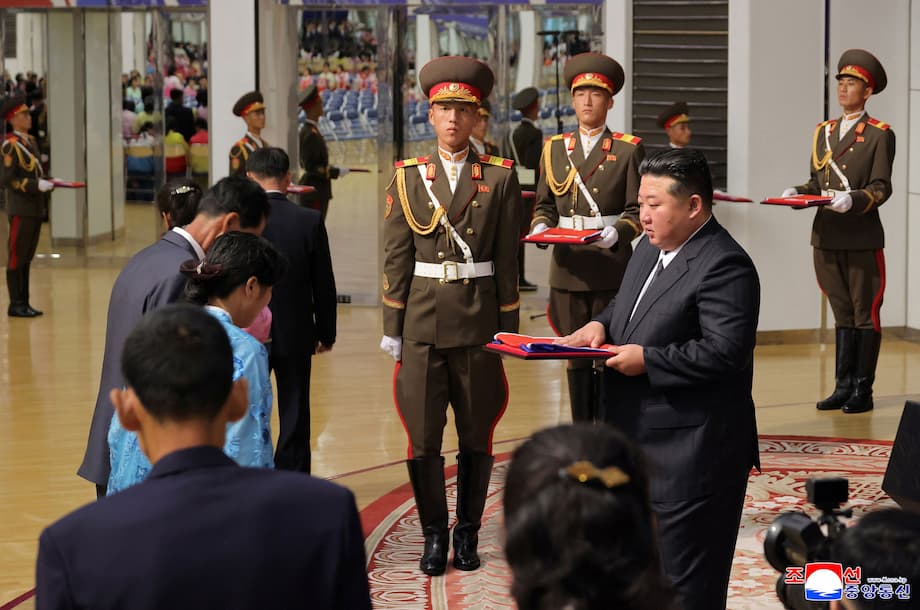North Korea’s Costly Gamble: Kim Jong Un Promises Support to Families of Soldiers Killed Fighting for Russia
In a rare and emotionally charged series of ceremonies, North Korean leader Kim Jong Un has publicly acknowledged the deaths of hundreds of his country’s soldiers fighting alongside Russian forces in the war against Ukraine. Promising a “beautiful life” for the bereaved families, Kim’s remarks and actions mark a significant moment in the deepening alliance between Pyongyang and Moscow—and a dramatic escalation of North Korea’s involvement in a European conflict.
- North Korea’s Costly Gamble: Kim Jong Un Promises Support to Families of Soldiers Killed Fighting for Russia
- Why Did North Korea Send Troops to Fight for Russia?
- Inside the Ceremonies: Kim’s Emotional Appeal and Political Calculations
- What Role Did North Korean Troops Play in the War?
- What Is North Korea Getting in Return?
- What Comes Next for North Korean Troops and Their Families?
- In Summary
As images of Kim bowing deeply to grieving parents, wives, and children were broadcast on North Korean state television, the world was offered a glimpse into the human cost of Pyongyang’s decision to send thousands of troops to Russia’s front lines. The ceremonies, which included the presentation of posthumous awards and heartfelt condolences, were the first public admission of the scale of North Korean casualties in Ukraine, and they underscore the risks and ambitions driving North Korea’s foreign policy.
Why Did North Korea Send Troops to Fight for Russia?
North Korea’s direct military involvement in the Russia-Ukraine war is unprecedented in recent history. While Pyongyang has long supported Moscow diplomatically and supplied arms, the deployment of combat troops marks a new phase in the relationship. According to South Korean and Western intelligence, North Korea sent between 10,000 and 15,000 soldiers to Russia, primarily to the Kursk region, beginning in the fall of 2024. This move followed a mutual defense pact signed by Kim Jong Un and Russian President Vladimir Putin, which pledged military support in the event of aggression against either country.
For Russia, the influx of North Korean troops helped address critical manpower shortages as the war dragged into its third year and Russian casualties mounted. For North Korea, the deployment offered several potential benefits:
- Access to advanced Russian military technology, including drones, missile systems, and satellite know-how
- Economic compensation for each soldier sent, with reports of monthly salaries and state incentives
- Diplomatic leverage and a chance to strengthen ties with a major global power
- Combat experience for its military, which had not fought abroad since the Korean War
North Korea’s participation also signaled its willingness to challenge international norms and deepen its isolation from the West, while betting on the benefits of a closer partnership with Russia.
How Many North Korean Soldiers Have Been Killed?
The true scale of North Korean casualties remains shrouded in secrecy, but estimates from South Korean intelligence and Western officials suggest that at least 600 North Korean soldiers have been killed, with thousands more wounded. Some sources put the total number of casualties (killed and wounded) as high as 4,700 out of a deployment of 15,000. Ukrainian and U.S. intelligence have reported similar figures, and Ukrainian special forces have described fierce and often desperate tactics by North Korean units on the battlefield.
At a recent ceremony in Pyongyang, Kim Jong Un honored the families of 100 fallen soldiers, hugging children and presenting portraits of the deceased wrapped in the national flag. State media showed Kim kneeling before a portrait of a fallen soldier and placing medals and flowers beside images of the dead. These highly publicized events are unusual for North Korea, which rarely admits to military losses, especially during ongoing conflicts.
Inside the Ceremonies: Kim’s Emotional Appeal and Political Calculations
The ceremonies for the bereaved families were laden with symbolism and political messaging. Kim Jong Un expressed deep regret for not being able to save the “precious lives” of the fallen, telling families that their loved ones’ sacrifices would be honored by the state. He promised full support for the children of the deceased, including plans to build a monument in Pyongyang and name a new street for the bereaved families.
“My heart aches and is bitter as I face the reality that I only get to meet the noble figures who gave up their precious lives for great victory and glory through photos on the memorial wall,” Kim said in a speech, according to North Korean state media.
Kim’s remarks were echoed by Russian President Vladimir Putin, who sent a letter describing North Korean troops as “heroic” and recalling the historic bonds between the two countries. The ceremonies also served to justify the deployment and boost morale at home, as North Korea faces growing economic hardship and international isolation.
Propaganda, Patriotism, and the Human Cost
North Korean state media has framed the fallen soldiers as martyrs who defended the nation’s honor and contributed to a “great feat” on the battlefield. The regime has praised the families as “the most tenacious, patriotic, and just people in the world,” and promised to take care of them as a matter of national duty. The emotional displays—Kim embracing sobbing children, bowing to grieving parents—are part of a carefully orchestrated campaign to reinforce loyalty and sacrifice as core values of the North Korean state.
Yet behind the propaganda lies a stark reality: many of the soldiers sent to Russia were young men with little real-world combat experience, facing a brutal and unfamiliar conflict far from home. Ukrainian commanders have described North Korean troops as highly disciplined and physically resilient, but also as lacking familiarity with modern warfare and Russian military systems. Early in their deployment, North Korean units suffered heavy losses, often moving in large, exposed groups and displaying a willingness to risk their lives to retrieve the bodies of fallen comrades.
What Role Did North Korean Troops Play in the War?
Initially, analysts believed North Korean troops would be assigned to non-combat roles, such as engineering or construction, due to their lack of battlefield experience. However, reports from the front lines indicate that North Korean units have been directly engaged in combat, particularly in the Kursk region, where Ukrainian forces launched a surprise incursion in the summer of 2024.
Ukrainian soldiers who fought against North Korean units described their adversaries as moving together in large, disciplined groups, often undeterred by drone and artillery fire. Some North Korean soldiers reportedly wrapped themselves in Mylar ponchos to avoid detection by thermal imaging, but this made them more visible to drones. Ukrainian drone operators noted that North Korean troops became increasingly skilled at shooting down drones and adapting to electronic warfare tactics.
“The North Koreans went from suffering massive losses to learning electronic warfare. They went from using World War II tactics to managing on the battlefield with drones, and they learned very quickly,” said a Ukrainian special operations soldier who fought in Kursk.
By March 2025, Russian and North Korean forces had pushed Ukrainian troops out of most of Kursk, and North Korean soldiers were honored at Russia’s Victory Day celebrations in May. The experience gained by North Korean troops in drone warfare and modern combat has raised concerns in South Korea and among Western analysts, who fear that Pyongyang could use these new skills in future conflicts on the Korean Peninsula.
Brutal Tactics and Reluctance to Surrender
Accounts from Ukrainian soldiers and defectors suggest that North Korean troops are highly indoctrinated and loyal to Kim Jong Un, with a strong aversion to surrender. There have been reports of North Korean soldiers detonating grenades to avoid capture, and of families facing severe consequences if their loved ones are taken prisoner. Ukrainian forces have captured a small number of wounded North Korean soldiers, but most have died before reaching medical facilities.
Despite their lack of recent combat experience, North Korean troops have demonstrated a willingness to adapt and learn, particularly in the use of drones and electronic warfare. Russian commanders have reportedly provided additional training to North Korean units, and there are indications that Pyongyang is seeking to acquire advanced Russian military technology in exchange for its support.
What Is North Korea Getting in Return?
North Korea’s decision to send troops to Russia was not made lightly. In addition to economic compensation, Pyongyang is believed to be seeking access to Russian military technology, including guidance on building long-range drones, improving missile accuracy, and developing reconnaissance satellites. Russian technical assistance could significantly enhance North Korea’s military capabilities, especially in areas related to its nuclear and ballistic missile programs.
There are also reports of North Korean workers being sent to Russia for construction and demining operations, in violation of United Nations sanctions. The economic benefits of these deployments, combined with the potential for technological gains, have made the alliance with Russia a high-stakes gamble for Kim Jong Un.
International Reactions and Regional Implications
The deployment of North Korean troops to fight in Ukraine has drawn condemnation from Ukraine, the United States, and NATO, who warn that it risks internationalizing the conflict and undermining efforts to reach a peace settlement. South Korea has expressed grave concern, fearing that North Korea’s combat experience and new military capabilities could be used against the South in the future. Seoul has even indicated it may consider providing defensive aid to Ukraine, a significant shift in its longstanding policy.
Germany and other Western countries have called for stronger sanctions against both Russia and North Korea, while the United Nations has warned of the dangers of escalating the war. The deepening military alliance between Pyongyang and Moscow has also raised questions about the future of the global security order, as authoritarian regimes seek to challenge Western influence and norms.
What Comes Next for North Korean Troops and Their Families?
Despite Kim Jong Un’s suggestion that North Korea’s involvement in Russia’s war could be ending, it remains unclear how many North Korean troops remain on the front lines or whether additional deployments are planned. Ukrainian and Western intelligence have warned that Pyongyang could send tens of thousands more soldiers if the war continues, and that North Korean laborers in Russia could be enticed into signing military contracts.
For the families of the fallen, Kim’s promises of a “beautiful life” and state support are both a source of comfort and a reminder of the sacrifices demanded by the regime. The construction of monuments, the naming of streets, and the provision of benefits are all part of a broader effort to maintain loyalty and morale in the face of mounting losses.
The Broader Significance: A New Era of Military Alliances
The public acknowledgment of North Korean casualties in Ukraine marks a turning point in Pyongyang’s foreign policy and its relationship with Moscow. The deepening military alliance between the two countries has implications far beyond the battlefields of Ukraine, potentially reshaping the security landscape in Northeast Asia and beyond.
As Kim Jong Un prepares to meet Vladimir Putin and Chinese President Xi Jinping at a military parade in Beijing, the world will be watching closely to see how this new axis of authoritarian powers evolves—and what it means for the future of global conflict.
In Summary
- Kim Jong Un has publicly acknowledged the deaths of hundreds of North Korean soldiers fighting for Russia in Ukraine, promising support to their families.
- North Korea sent between 10,000 and 15,000 troops to Russia’s Kursk region, with at least 600 killed and thousands more wounded, according to intelligence estimates.
- The deployment followed a mutual defense pact between Kim and Putin, deepening military and diplomatic ties between Pyongyang and Moscow.
- North Korean troops have gained valuable combat experience, particularly in drone warfare, raising concerns in South Korea and among Western analysts.
- Pyongyang is believed to be seeking advanced Russian military technology and economic compensation in exchange for its support.
- The public ceremonies and promises to bereaved families are part of a broader campaign to reinforce loyalty and justify the costly deployment.
- International reactions have been sharply critical, with calls for stronger sanctions and warnings about the risks of further escalation.
- The future of North Korea’s involvement in the war remains uncertain, as Kim signals both an end to operations and the possibility of further deployments.




